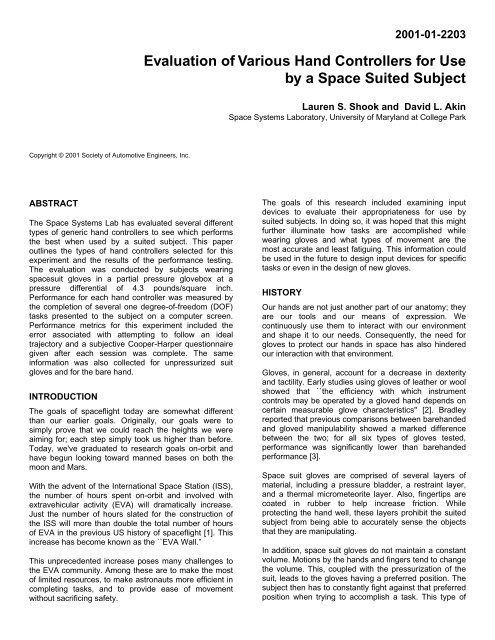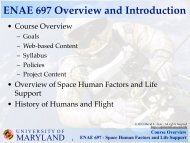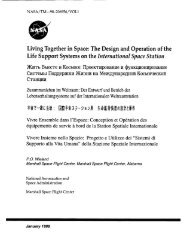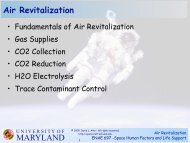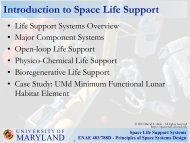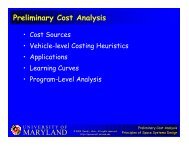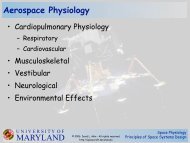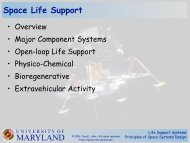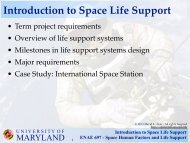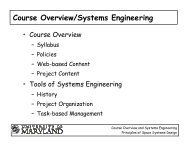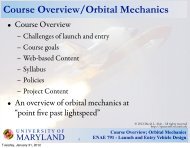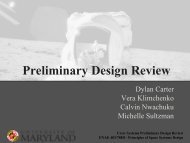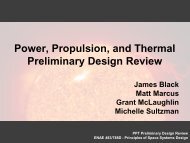Evaluation of Various Hand Controllers for Use by - University of ...
Evaluation of Various Hand Controllers for Use by - University of ...
Evaluation of Various Hand Controllers for Use by - University of ...
You also want an ePaper? Increase the reach of your titles
YUMPU automatically turns print PDFs into web optimized ePapers that Google loves.
Copyright © 2001 Society <strong>of</strong> Automotive Engineers, Inc.<br />
ABSTRACT<br />
The Space Systems Lab has evaluated several different<br />
types <strong>of</strong> generic hand controllers to see which per<strong>for</strong>ms<br />
the best when used <strong>by</strong> a suited subject. This paper<br />
outlines the types <strong>of</strong> hand controllers selected <strong>for</strong> this<br />
experiment and the results <strong>of</strong> the per<strong>for</strong>mance testing.<br />
The evaluation was conducted <strong>by</strong> subjects wearing<br />
spacesuit gloves in a partial pressure glovebox at a<br />
pressure differential <strong>of</strong> 4.3 pounds/square inch.<br />
Per<strong>for</strong>mance <strong>for</strong> each hand controller was measured <strong>by</strong><br />
the completion <strong>of</strong> several one degree-<strong>of</strong>-freedom (DOF)<br />
tasks presented to the subject on a computer screen.<br />
Per<strong>for</strong>mance metrics <strong>for</strong> this experiment included the<br />
error associated with attempting to follow an ideal<br />
trajectory and a subjective Cooper-Harper questionnaire<br />
given after each session was complete. The same<br />
in<strong>for</strong>mation was also collected <strong>for</strong> unpressurized suit<br />
gloves and <strong>for</strong> the bare hand.<br />
INTRODUCTION<br />
The goals <strong>of</strong> spaceflight today are somewhat different<br />
than our earlier goals. Originally, our goals were to<br />
simply prove that we could reach the heights we were<br />
aiming <strong>for</strong>; each step simply took us higher than be<strong>for</strong>e.<br />
Today, we've graduated to research goals on-orbit and<br />
have begun looking toward manned bases on both the<br />
moon and Mars.<br />
With the advent <strong>of</strong> the International Space Station (ISS),<br />
the number <strong>of</strong> hours spent on-orbit and involved with<br />
extravehicular activity (EVA) will dramatically increase.<br />
Just the number <strong>of</strong> hours slated <strong>for</strong> the construction <strong>of</strong><br />
the ISS will more than double the total number <strong>of</strong> hours<br />
<strong>of</strong> EVA in the previous US history <strong>of</strong> spaceflight [1]. This<br />
increase has become known as the ``EVA Wall.”<br />
This unprecedented increase poses many challenges to<br />
the EVA community. Among these are to make the most<br />
<strong>of</strong> limited resources, to make astronauts more efficient in<br />
completing tasks, and to provide ease <strong>of</strong> movement<br />
without sacrificing safety.<br />
2001-01-2203<br />
<strong>Evaluation</strong> <strong>of</strong> <strong>Various</strong> <strong>Hand</strong> <strong>Controllers</strong> <strong>for</strong> <strong>Use</strong><br />
<strong>by</strong> a Space Suited Subject<br />
Lauren S. Shook and David L. Akin<br />
Space Systems Laboratory, <strong>University</strong> <strong>of</strong> Maryland at College Park<br />
The goals <strong>of</strong> this research included examining input<br />
devices to evaluate their appropriateness <strong>for</strong> use <strong>by</strong><br />
suited subjects. In doing so, it was hoped that this might<br />
further illuminate how tasks are accomplished while<br />
wearing gloves and what types <strong>of</strong> movement are the<br />
most accurate and least fatiguing. This in<strong>for</strong>mation could<br />
be used in the future to design input devices <strong>for</strong> specific<br />
tasks or even in the design <strong>of</strong> new gloves.<br />
HISTORY<br />
Our hands are not just another part <strong>of</strong> our anatomy; they<br />
are our tools and our means <strong>of</strong> expression. We<br />
continuously use them to interact with our environment<br />
and shape it to our needs. Consequently, the need <strong>for</strong><br />
gloves to protect our hands in space has also hindered<br />
our interaction with that environment.<br />
Gloves, in general, account <strong>for</strong> a decrease in dexterity<br />
and tactility. Early studies using gloves <strong>of</strong> leather or wool<br />
showed that ``the efficiency with which instrument<br />
controls may be operated <strong>by</strong> a gloved hand depends on<br />
certain measurable glove characteristics" [2]. Bradley<br />
reported that previous comparisons between barehanded<br />
and gloved manipulability showed a marked difference<br />
between the two; <strong>for</strong> all six types <strong>of</strong> gloves tested,<br />
per<strong>for</strong>mance was significantly lower than barehanded<br />
per<strong>for</strong>mance [3].<br />
Space suit gloves are comprised <strong>of</strong> several layers <strong>of</strong><br />
material, including a pressure bladder, a restraint layer,<br />
and a thermal micrometeorite layer. Also, fingertips are<br />
coated in rubber to help increase friction. While<br />
protecting the hand well, these layers prohibit the suited<br />
subject from being able to accurately sense the objects<br />
that they are manipulating.<br />
In addition, space suit gloves do not maintain a constant<br />
volume. Motions <strong>by</strong> the hands and fingers tend to change<br />
the volume. This, coupled with the pressurization <strong>of</strong> the<br />
suit, leads to the gloves having a preferred position. The<br />
subject then has to constantly fight against that preferred<br />
position when trying to accomplish a task. This type <strong>of</strong>
compensation can lead to muscle fatigue, especially in<br />
the fingers and wrist [4].<br />
In the next hundred years <strong>of</strong> space exploration, we are<br />
looking toward larger scale missions and more<br />
complicated tasks than ever be<strong>for</strong>e in our history. Future<br />
exploration <strong>of</strong> both the Moon and Mars will require a<br />
great deal <strong>of</strong> planning and development <strong>of</strong> new<br />
technology in order to be carried out successfully. Given<br />
the success <strong>of</strong> smaller robots, such as Sojourner, on<br />
Mars, it seems only logical that robots would play a role<br />
in future planetary exploration missions. It has been<br />
proposed [5], [6], [7] that a larger robot would be useful<br />
as an astronaut assistant <strong>for</strong> planetary exploration. Such<br />
a robot would be capable <strong>of</strong> carrying scientific<br />
equipment, storing samples, and carrying consumables<br />
<strong>for</strong> the astronaut. It could also serve as a terrain scout or<br />
take video <strong>of</strong> an interesting area.<br />
Field testing has shown that it would be advantageous<br />
that the ``EVA crewmember be provided with some<br />
control <strong>of</strong> the rover" and future study was recommended<br />
to develop ``methods <strong>for</strong> the suited subject to control the<br />
robotic rover" [8].<br />
Gloves hold their own unique limitations, such as limited<br />
range <strong>of</strong> motion and dexterity. These impact the<br />
per<strong>for</strong>mance <strong>of</strong> hand controllers designed <strong>for</strong> nude body<br />
per<strong>for</strong>mance. To this end, a control method appropriate<br />
to a suited subject would need to be found.<br />
This experiment was designed to illustrate which basic<br />
type <strong>of</strong> hand controller would be the most appropriate <strong>for</strong><br />
use <strong>by</strong> a suited subject. Also, it is hoped that the results<br />
may provide insight into designing hand controllers <strong>for</strong><br />
future missions, both <strong>for</strong> EVA and planetary surface<br />
exploration. In addition, these experiments may provide<br />
insight into the per<strong>for</strong>mance <strong>of</strong> space suit gloves.<br />
EXPERIMENT DESIGN<br />
DESIGN GOALS<br />
This experiment uses four separate one degree-<strong>of</strong>freedom<br />
(DOF) tasks displayed on a computer to test the<br />
per<strong>for</strong>mance <strong>of</strong> several different hand controllers. Each<br />
subject completed all four tasks under three different<br />
conditions: no glove, unpressurized glove, and<br />
pressurized glove. The details <strong>of</strong> these input devices and<br />
the tasks that were presented are outlined in the<br />
remainder <strong>of</strong> this section.<br />
HAND CONTROLLER TYPES<br />
Four different hand controller types were selected <strong>for</strong> this<br />
experiment. The selection criteria and the types selected<br />
are discussed below. The goal behind these choices was<br />
to represent both current styles <strong>of</strong> input devices and new<br />
and innovative methods.<br />
SELECTION CRITERIA<br />
A working definition <strong>of</strong> prehension has been stated as<br />
``the application <strong>of</strong> functionally effective <strong>for</strong>ces <strong>by</strong> the<br />
hand to an object <strong>for</strong> a task, given numerous constraints"<br />
[9]. The hand has the ability to move in many different<br />
ways to complete tasks, but some movements and hand<br />
shapes are more effective than others. In completing a<br />
task, three demands are placed upon the hand and its<br />
posture:<br />
1. Apply <strong>for</strong>ces to match the anticipated <strong>for</strong>ces in the<br />
task (stable grasp)<br />
2. Impart motion to the object (manipulate) or transport<br />
the object as necessary<br />
3. Gather sensory in<strong>for</strong>mation about the state <strong>of</strong><br />
interaction with the object during the task in order to<br />
ensure grasping and manipulative stability [10].<br />
Many postures <strong>of</strong> the hand have been catalogued over<br />
the years. A simple set <strong>of</strong> hand postures was developed<br />
<strong>by</strong> G. Schlesinger in 1919 in order to categorize the<br />
functionality <strong>of</strong> prosthetic hands [11]. The basic set <strong>of</strong> six<br />
postures include cylindrical, fingertip, hook, palmar,<br />
spherical, and lateral.<br />
The goal <strong>of</strong> this selection was to choose each controller<br />
to be representative <strong>of</strong> a basic type <strong>of</strong> hand motion. In<br />
this way, it could be seen how well the types <strong>of</strong> hand<br />
motions could be used to complete tasks while wearing a<br />
suit glove. All <strong>of</strong> the devices selected were commercial<br />
<strong>of</strong>f-the-shelf devices, designed <strong>for</strong> barehanded use. It<br />
was hoped that a clear differentiation would be seen<br />
between the four input devices under the three gloved<br />
conditions, indicating which type <strong>of</strong> motion might be more<br />
appropriate <strong>for</strong> use <strong>by</strong> a gloved subject.<br />
TYPES SELECTED<br />
The following hand controller types were selected <strong>for</strong> this<br />
experiment: Mouse, Touchpad, Joystick, and Magnetic<br />
motion sensor. They can be seen in Figure 1.<br />
Figure 1: <strong>Hand</strong> <strong>Controllers</strong> Selected from L to R:<br />
Touchpad, Mouse, Joystick, Magnetic Motion Sensor.
Mouse<br />
The mouse was selected as a typical input device that all<br />
subjects would be familiar with. The motion involved is a<br />
side to side motion in a single plane. Using this device<br />
also requires the subject to be able to hold the input<br />
device in a spherical grip and control its motion. While it<br />
is clear that the mouse would not be suitable as an<br />
operational input device, it provides a useful comparison<br />
point <strong>for</strong> the other controllers.<br />
Joystick<br />
The joystick chosen here was an Advanced Gravis (PC),<br />
Gravis Destroyer PC Joystick. This is a standard three<br />
DOF PC joystick. A fourth DOF can be enabled using a<br />
wheel on the base <strong>of</strong> the joystick, but was not enabled <strong>for</strong><br />
this experiment. This hand controller requires that the<br />
subject be able to grip the handle in a cylindrical posture<br />
and move about the neutral zero position.<br />
Touchpad<br />
A touchpad is an input device that uses an interruption <strong>of</strong><br />
the conductive surface to recognize the user's position on<br />
the surface <strong>of</strong> the pad. Touchpads are typically a ``single<br />
plastic mylar membrane silkscreened with a silver<br />
conductive grid and two resistive strips." [12] When<br />
touched, the X and Y resistances are measured and the<br />
position is calculated. The body typically provides the<br />
conductive surface that registers on the touchpad's<br />
surface. For the gloved test cases, a ground wire was<br />
required to be attached to the glove's fingertip in order to<br />
use this input device. The touchpad chosen <strong>for</strong> this<br />
experiment was a Cirque Easy Cat Touchpad, which can<br />
be seen in Figure 1.<br />
Touchpads or advanced LCD displays have long been<br />
considered candidates <strong>for</strong> controllers on EVA missions.<br />
The NASA EVA Research and Technology Roadmap <strong>of</strong><br />
September 1999 shows interest in developing a ``small<br />
lightweight cuff mounted or visor integrated display<br />
system." [13] In this vein, the touchpad was placed on<br />
the back <strong>of</strong> the left hand using Velcro loops. The subject<br />
was then able to use a fingertip from the right hand to<br />
control the touchpad.<br />
Magnetic motion sensor<br />
Flock <strong>of</strong> Birds is a motion sensing package designed <strong>by</strong><br />
Ascension Technology Corporation. It is capable <strong>of</strong><br />
tracking up to 4 sensors simultaneously. However, <strong>for</strong><br />
this experiment only one sensor was needed. Each<br />
sensor position is measured relative to the fixed<br />
transmitting antenna, which is driven <strong>by</strong> a pulsed, direct<br />
current (DC) signal. The receiving antenna measures<br />
both the transmitted pulse and the earth's magnetic field.<br />
A microprocessor controls both the transmission and<br />
receiving sides, as well as processing the received signal<br />
into position and orientation data. [14] The system can be<br />
seen in Figure 1.<br />
The magnetic position sensor was placed on the back <strong>of</strong><br />
the right hand and held in place using a Velcro strip. In<br />
this case, the motion involved is <strong>of</strong> the arm to position the<br />
hand.<br />
TASK SELECTION<br />
The tasks chosen <strong>for</strong> this experiment were designed to<br />
be simple, so that the response could be studied in only<br />
one degree <strong>of</strong> freedom. It was thought that a one DOF<br />
task would be similar to that <strong>of</strong> adjusting a heading angle<br />
or increasing/decreasing speed; tasks that might be<br />
applicable to controlling an astronaut assistant rover.<br />
The following sections will discuss the four one DOF<br />
tasks chosen, the theory behind them, and the<br />
per<strong>for</strong>mance metrics used to evaluate the results.<br />
Tracking Tasks<br />
Typically, human per<strong>for</strong>mance is measured using an<br />
``in<strong>for</strong>mation processing approach." [15] These are tasks<br />
where a stimulus is presented to the subject and the<br />
result <strong>of</strong> the reaction to that stimulus can be measured. A<br />
type <strong>of</strong> continuous test used <strong>by</strong> many researchers is a<br />
tracking test. In a tracking test, the subject is presented<br />
with an ideal case and asked to mimic it as best possible,<br />
keeping the error to a minimum.<br />
The four tracking tests used <strong>for</strong> this experiment can be<br />
classified into two types, pursuit and compensatory.<br />
Three pursuit tasks were chosen with the following ideal<br />
trajectories: a sine wave, a sine sweep, and a step. The<br />
fourth task was a compensatory tracking task using a<br />
sine wave as the target path. These tasks are discussed<br />
in more detail below.<br />
Pursuit Tracking Tasks<br />
Pursuit tracking tasks are defined as those in which ``the<br />
instantaneous reference input r and the instantaneous<br />
controlled input y are both displayed to the human<br />
operator separately and independently, so that he may<br />
distinguish individual properties <strong>of</strong> these signals <strong>by</strong> direct<br />
observation." [16] In this case, two icons representing the<br />
reference input, or target, and the controlled input were<br />
displayed to the subject. As seen in Figure 2, the target<br />
icon was displayed on screen above the controlled icon,<br />
to remove any confusion should the objects overlap.<br />
Subjects were asked to follow the target icon as closely<br />
as possible using the controlled icon.<br />
The first pursuit task was following a simple sine wave,<br />
fixed in amplitude. The reason <strong>for</strong> choosing this tracking<br />
task was to examine the mean error <strong>for</strong> a simple,<br />
unchanging task. The second task was following a sine<br />
wave sweep. In this case, the amplitude <strong>of</strong> the sine wave<br />
remained fixed while the frequency increases during the<br />
test. It was hoped to gain both mean error and frequency<br />
response data from this task. Lastly, a step pursuit task
was chosen. In this case, the target icon begins at zero,<br />
and then jumps to a set distance on the screen. From<br />
this test, it was hoped to collect data on settling time,<br />
overshoot, and error.<br />
Figure 2: Controlled and Target Icons<br />
Compensatory Tracking Task<br />
A second type <strong>of</strong> tracking task is called compensatory<br />
tracking. This is defined as ``one in which the human<br />
operator has a single input, the error e, the difference<br />
between actual system response y and ideal response<br />
(the reference input)." [17]<br />
For this experiment, the subjects only viewed an icon<br />
representing the error present in the test and a vertical<br />
line on the screen at zero. This can be seen in Figure 3.<br />
They attempted to keep the icon on the line, using the<br />
various hand controllers. The reference input <strong>for</strong> this<br />
case was unknown to the subjects and was a simple sine<br />
wave, identical to the first pursuit tracking task.<br />
This task is considered to be advantageous, since inputoutput<br />
characteristics <strong>of</strong> the system can be measured<br />
directly. This is because the human operator is assumed<br />
to be a function <strong>of</strong> one variable, the error, instead <strong>of</strong> two,<br />
the input and the output. [18]<br />
Per<strong>for</strong>mance Metrics<br />
The per<strong>for</strong>mance metrics <strong>for</strong> this experiment include both<br />
analytical and subjective. As stated above, the mean<br />
error involved in task completion was calculated <strong>for</strong> all<br />
tracking tasks and compared between hand controllers. It<br />
was hoped that this would give a clear indication <strong>of</strong> which<br />
hand controller might be appropriate <strong>for</strong> use <strong>by</strong> a gloved<br />
subject.<br />
The sine sweep task was examined <strong>for</strong> the frequency<br />
response <strong>of</strong> the subject, as well as <strong>for</strong> mean error. For<br />
the step task, settling time and overshoot were<br />
examined.<br />
Subjective data was taken using a modified Cooper<br />
Harper rating scale <strong>for</strong> each hand controller under each<br />
glove condition. Subject comments on tactility, dexterity,<br />
and fatigue were also recorded.<br />
Figure 3: Compensatory Tracking Task<br />
The results given in this paper will be limited to the mean<br />
error <strong>for</strong> the sine, sine sweep and compensatory tracking<br />
results and the Cooper-Harper subject ratings. A more<br />
detailed description <strong>of</strong> the experiment, complete results,<br />
and subject comments can be found in [19].<br />
EXPERIMENTAL SETUP<br />
All subject testing was conducted at the Space Systems<br />
Laboratory, at the <strong>University</strong> <strong>of</strong> Maryland. A differential<br />
pressure glovebox, on loan from NASA Goddard<br />
Spaceflight Center, was used <strong>for</strong> all <strong>of</strong> the tests. In both<br />
the barehanded and unpressurized glove cases, the<br />
subject completed the tests in an open, unpressurized<br />
glovebox. This was done to maintain the same<br />
constraints on arm position as the pressurized glove<br />
tests. The glovebox used is constructed <strong>of</strong> Plexiglas and<br />
operates at a 4.3 PSI pressure differential.<br />
In order to use the hand controllers in the pressurized<br />
glovebox, a new end plate needed to be designed. The<br />
plate was designed to fit the previous interface and<br />
included connectors <strong>for</strong> all <strong>of</strong> the hand controllers.<br />
LAYOUT<br />
The glovebox was set up in the following way <strong>for</strong> all tests.<br />
A flat panel monitor was placed inside the glovebox, to<br />
the left <strong>of</strong> the subject, on a low table. The subject could<br />
change both the position and the orientation <strong>of</strong> the<br />
monitor. Each input device was positioned <strong>by</strong> the subject<br />
to where it was com<strong>for</strong>table and operated the easiest.<br />
Figure 4 shows the glovebox with monitor and input<br />
devices. Subjects were permitted to either stand or sit<br />
while completing each series <strong>of</strong> tests.
Figure 4: Glovebox Setup<br />
SOFTWARE<br />
The s<strong>of</strong>tware <strong>for</strong> this experiment was written in C, using<br />
Open GL, GL utilities (GLUT), and a graphics package<br />
called World Modeler. A separate program was written<br />
<strong>for</strong> each input device. Each program recorded subject<br />
number, test number, test condition (bare-handed,<br />
unpressurized glove, pressurized glove), and trial<br />
number. Based on these inputs, the proper task was<br />
displayed on the screen <strong>for</strong> the subject. The data file <strong>for</strong><br />
each completed task included time, actual position,<br />
desired position, and position error.<br />
GLOVES<br />
Two gloves were used <strong>for</strong> this experiment. The righthanded<br />
glove was a Shuttle suit glove, series 3000, on<br />
loan from ILC Dover. It can be seen in Figure 5. This was<br />
not a standard glove, however, and used an<br />
experimental Thermal Micrometeorite Garment (TMG)<br />
not found on standard 3000 series gloves. Any results<br />
contained herein do not accurately reflect the<br />
per<strong>for</strong>mance <strong>of</strong> any specific type <strong>of</strong> glove, but are simply<br />
meant to illuminate the general per<strong>for</strong>mance <strong>of</strong><br />
pressurized gloves.<br />
The left glove used was a Skylab suit glove. The<br />
connection ring was redesigned to fit the wrist connection<br />
<strong>of</strong> a shuttle glovebox arm segment. This glove, as seen<br />
in Figure 5, was not used to control any <strong>of</strong> the hand<br />
controllers. Its purpose was to allow the use <strong>of</strong> the<br />
touchpad on the back <strong>of</strong> the left hand under pressurized<br />
conditions.<br />
Both gloves were connected to Shuttle arm segments.<br />
The glove and segments were then placed in the glove<br />
ports <strong>of</strong> the glovebox.<br />
All subjects selected were right-handed; this was<br />
deemed best to utilize the superior features <strong>of</strong> the more<br />
modern glove. Since only one set <strong>of</strong> gloves was available<br />
<strong>for</strong> testing, it was not practical to attempt to limit test<br />
subjects to those with ideal fits to the gloves. In order to<br />
assess the impacts <strong>of</strong> this limitation, hand measurements<br />
were taken <strong>of</strong> each subject, along with measurements <strong>of</strong><br />
the gloves used.<br />
Figure 5: Left and Right Gloves<br />
TEST PROCEDURE<br />
The test matrix was comprised <strong>of</strong> four input devices,<br />
three glove conditions, four tasks to be completed, and<br />
five trials <strong>for</strong> each. There<strong>for</strong>e, each input device required<br />
60 trials. This resulted in a total <strong>of</strong> 240 trials <strong>for</strong> each<br />
subject and 1440 trials <strong>for</strong> the whole experiment. These<br />
were broken up into four sessions, one <strong>for</strong> each input<br />
device. Each session lasted approximately an hour and<br />
half in duration.<br />
Prior to the start <strong>of</strong> testing, the entire testing procedure<br />
was explained to each subject and they were asked to fill<br />
out an in<strong>for</strong>med consent <strong>for</strong>m and a pre-test<br />
questionnaire. Subjects typically completed each series<br />
<strong>of</strong> trials <strong>for</strong> a single input device in an hour and a half.<br />
For each input device, each subject began with<br />
barehanded testing. They began with test 0, the sine<br />
wave, and completed five 30 second trials. Next, they<br />
completed five 30 second trials <strong>of</strong> the sine sweep, test 1.<br />
Third was five trials <strong>of</strong> test 2, the step, which took<br />
approximately 15-20 seconds to complete. Lastly, they<br />
completed five 30 second trials <strong>of</strong> the compensatory<br />
tracking test. This same sequence was then repeated<br />
with the unpressurized glove, and then the pressurized<br />
glove.<br />
After the sequence was completed <strong>for</strong> each glove<br />
condition, the subject filled out a post-test questionnaire<br />
and gave the input device a Cooper-Harper rating.<br />
The procedure above was followed <strong>for</strong> all input devices.<br />
All subjects began with the mouse, but there was no<br />
specific order <strong>for</strong> the other three devices. Total subject<br />
testing time was approximately six hours.<br />
RESULTS<br />
MEAN ERROR RESULTS<br />
The mean error was taken <strong>for</strong> each trial. Then all <strong>of</strong> the<br />
trials <strong>for</strong> all <strong>of</strong> the subjects were complied <strong>for</strong> each task<br />
type. The matrix <strong>for</strong> each task type consisted <strong>of</strong> 360 data<br />
points. An Analysis <strong>of</strong> Variance (ANOVA) was run <strong>for</strong>
each task using the SAS program, as was a Duncan<br />
range grouping.<br />
SINE WAVE<br />
Looking at the ANOVA results <strong>for</strong> the sine wave task, the<br />
subject, glove condition, and hand controller type are all<br />
statistically significant to the .0001 level. The trial number<br />
was not found to be statistically significant to the .001<br />
level <strong>for</strong> this task.<br />
Source Pr>F<br />
Subject .0001<br />
Glove Condition .0001<br />
<strong>Hand</strong> Controller .0001<br />
Trial Number .0837<br />
Table 1: ANOVA Results <strong>for</strong> Sine Wave<br />
The Duncan range grouping shows that subjects are<br />
clearly grouped <strong>by</strong> gender.<br />
Duncan Grouping Mean Subject Number<br />
A 1.10622 2<br />
A .96319 1<br />
A .95599 6<br />
B .70265 3<br />
B .67186 5<br />
B .65925 4<br />
Table 2: Duncan Range Grouping <strong>by</strong> Subject <strong>for</strong> Sine<br />
Wave<br />
Group A consists <strong>of</strong> subjects 1,2, and 6, which are all<br />
female. While group B consists <strong>of</strong> subjects 3,4, and 5,<br />
which are all male. Initially, this appears to be similar to<br />
the gender per<strong>for</strong>mance results which Bishu and Klute<br />
reported [20]. However, in reviewing the subject data,<br />
this appears to be less <strong>of</strong> a gender effect and more an<br />
artifact <strong>of</strong> the subject’s hand size. Subject 4’s hands were<br />
slightly too large <strong>for</strong> the glove and had reported the glove<br />
as being too tight during several tests. Subjects 1 and 2<br />
both had similar hand sizes and both reported the glove<br />
as being too large and that they were unable to reach the<br />
ends <strong>of</strong> the fingertips.<br />
As one might expect, the pressurized glove condition had<br />
the worst mean error <strong>for</strong> this task. The bare-handed and<br />
the unpressurized glove conditions are part <strong>of</strong> the same<br />
Duncan range grouping.<br />
Duncan Grouping Mean Glove Condition<br />
A 1.01491 Glove Pressurized<br />
B .79592 Glove Unpressurized<br />
B .71875 Bare <strong>Hand</strong>ed<br />
Table 3: Duncan Range Grouping <strong>by</strong> Glove<br />
Condition <strong>for</strong> Sine Wave<br />
The results <strong>of</strong> the hand controllers <strong>for</strong> the sine wave task<br />
are shown in Table 4. The magnetic motion sensor had<br />
the best per<strong>for</strong>mance, followed <strong>by</strong> the mouse, and then<br />
the grouping <strong>of</strong> the touchpad and joystick.<br />
Duncan Grouping Mean <strong>Hand</strong> Controller<br />
A 1.06236 Touchpad<br />
A .98256 Joystick<br />
B .78086 Mouse<br />
C .54699 Magnetic motion<br />
sensor<br />
Table 4: Duncan Range Grouping <strong>by</strong> <strong>Hand</strong> Controller<br />
<strong>for</strong> Sine Wave<br />
Sine Sweep Task<br />
For the sine sweep task, the subject number, glove<br />
condition, and hand controller type were all found to be<br />
significant to the .0001 level. Again, the trial number was<br />
found to have no statistical significance.<br />
Source Pr>F<br />
Subject .0001<br />
Glove Condition .0001<br />
<strong>Hand</strong> Controller .0001<br />
Trial Number .9379<br />
Table 5: ANOVA Results <strong>for</strong> Sine Sweep
The same gender groupings were also seen <strong>for</strong> this task,<br />
however subjects 2 and 3 were also grouped as a third<br />
group. The reason <strong>for</strong> this third grouping is unclear.<br />
Duncan Grouping Mean Subject Number<br />
A 1.53396 1<br />
A 1.47185 6<br />
A B 1.34195 2<br />
C B 1.15550 3<br />
C 1.06336 5<br />
C 1.06218 4<br />
Table 7: Duncan Range Grouping <strong>by</strong> Subject <strong>for</strong> Sine<br />
Sweep<br />
Again, the results show that the pressurized glove has<br />
the largest mean. The bare handed and unpressurized<br />
glove conditions have a smaller mean, with the bare<br />
handed being the smallest, and are grouped together, as<br />
seen in Table 8.<br />
Duncan Grouping Mean Glove Condition<br />
A 1.46879 Glove Pressurized<br />
B 1.21456 Glove Unpressurized<br />
B 1.13105 Bare <strong>Hand</strong>ed<br />
Table 8: Duncan Range Grouping <strong>by</strong> Glove<br />
Condition <strong>for</strong> Sine Sweep<br />
The results <strong>of</strong> the hand controllers <strong>for</strong> the sine sweep<br />
task were more interrelated than those <strong>of</strong> the sine wave.<br />
The magnetic motion sensor had the lowest mean,<br />
followed <strong>by</strong> the grouping <strong>of</strong> the mouse and joystick, and<br />
then the grouping <strong>of</strong> the joystick and the touchpad. This<br />
grouping indicates that the mouse and joystick are<br />
statistically similar and the joystick and touchpad are also<br />
statistically similar, but the mouse and touchpad are not<br />
related.<br />
Duncan Grouping Mean <strong>Hand</strong> Controller<br />
A 1.46468 Touchpad<br />
A B 1.38003 Joystick<br />
C B 1.26444 Mouse<br />
C .97672 Magnetic motion<br />
sensor<br />
Table 9: Duncan Range Grouping <strong>by</strong> <strong>Hand</strong> Controller<br />
<strong>for</strong> Sine Sweep<br />
Compensatory Tracking Task<br />
The results from this task are different from those <strong>of</strong> the<br />
previous two tasks. The subject, glove condition, and<br />
hand controller type are all still statistically significant, but<br />
<strong>for</strong> this case the glove condition is now only significant to<br />
the .001 level (.0006) as opposed to the previous .0001<br />
level.<br />
Source Pr>F<br />
Subject .0001<br />
Glove<br />
Condition<br />
<strong>Hand</strong><br />
Controller<br />
.0006<br />
.0001<br />
Trial Number .4462<br />
Table 10: ANOVA Results <strong>for</strong> Compensatory<br />
Tracking Task<br />
Also, <strong>for</strong> this task the subject grouping is no longer<br />
strictly <strong>by</strong> gender; Subjects1, 2, 3, and 6 are now<br />
grouped, 3,4, and 6 are grouped, and 5 is grouped<br />
separately.<br />
Duncan Grouping Mean Subject Number<br />
A 1.34618 2<br />
A 1.25622 1<br />
A B 1.17907 3<br />
A B 1.15281 6<br />
B .98491 4<br />
C .72101 5<br />
Table 11: Duncan Range Grouping <strong>by</strong> Subject <strong>for</strong><br />
Compensatory Tracking Task<br />
Despite the glove condition being less significant, the<br />
results are still the same as in the previous two tasks.<br />
The pressurized glove has the highest mean and the<br />
bare handed and unpressurized glove conditions are still<br />
grouped.<br />
Duncan Grouping Mean Glove Condition<br />
A 1.22398 Glove Pressurized<br />
B 1.07663 Glove Unpressurized<br />
B 1.01969 Bare <strong>Hand</strong>ed<br />
Table 12: Duncan Range Grouping <strong>by</strong> Glove<br />
Condition <strong>for</strong> Compensatory Tracking Task
The hand controller results <strong>for</strong> the compensatory tracking<br />
task are as follows, the magnetic motion sensor has the<br />
lowest mean, then the mouse, the joystick, and finally the<br />
touchpad. The joystick and touchpad are grouped, while<br />
the magnetic motion sensor and mouse are in separate<br />
groups, as seen in Table 13.<br />
Duncan Grouping Mean <strong>Hand</strong> Controller<br />
A 1.44145 Touchpad<br />
A 1.12959 Joystick<br />
B .95229 Mouse<br />
C .90374 Magnetic motion<br />
sensor<br />
Table 13: Duncan Range Grouping <strong>by</strong> <strong>Hand</strong><br />
Controller <strong>for</strong> Compensatory Tracking Task<br />
COOPER-HARPER SUBJECT RATINGS<br />
The Cooper-Harper rating scale was originally designed<br />
to rate the flight handling qualities <strong>of</strong> aircraft <strong>by</strong> their<br />
pilots. It has evolved into a subjective method <strong>of</strong><br />
evaluating human interaction with a system. This<br />
experiment used a modified version <strong>of</strong> the Cooper-<br />
Harper rating system, which can be found in [21], where<br />
a rating <strong>of</strong> 1 is excellent and 10 indicates major<br />
deficiencies.<br />
Each subject gave the hand controller an overall rating,<br />
based on the tasks completed under all <strong>of</strong> the glove<br />
conditions. Figure 6 shows the ratings given <strong>for</strong> each<br />
hand controller under the barehanded condition.<br />
Figure 6: Modified Cooper-Harper Ratings For <strong>Hand</strong><br />
<strong>Controllers</strong> Under Barehanded Conditions<br />
As seen in the graph, the ratings vary <strong>by</strong> subject. Three<br />
agreed that the magnetic motion sensor did the best,<br />
while two tied it with other controllers. The mouse also<br />
did well; first with one subject and tied at first <strong>for</strong> two<br />
others. The joystick did badly as it had the highest rating<br />
<strong>for</strong> four subjects and was tied <strong>for</strong> the highest with the<br />
other two subjects. The touchpad ratings varied over all<br />
<strong>of</strong> the subjects.<br />
Figure 7 shows the Cooper-Harper ratings <strong>for</strong> the<br />
unpressurized glove conditions.<br />
Figure 7: Modified Cooper-Harper Ratings For <strong>Hand</strong><br />
<strong>Controllers</strong> Under Unpressurized Glove Conditions<br />
Here, three subjects agree that the magnetic motion<br />
sensor controller is best, while two have it tied <strong>for</strong> first<br />
with the mouse and a third with the joystick. The<br />
per<strong>for</strong>mance <strong>of</strong> the mouse has decreased from the<br />
barehanded, only being ranked as the best with two<br />
subjects.<br />
All <strong>of</strong> the ratings have increased from the barehanded<br />
ratings, indicating the increased difficulty with the glove.<br />
The pressurized glove ratings can be seen in Figure 8.<br />
Figure 8: Modified Cooper-Harper Ratings For <strong>Hand</strong><br />
<strong>Controllers</strong> Under Pressurized Glove Conditions<br />
In this case, there is a consensus between all subjects<br />
that the magnetic motion sensor controller has per<strong>for</strong>med<br />
(or tied in one case) the best. The other three hand
controllers are subject specific, and there is no clear<br />
trend.<br />
CONCLUSION<br />
Overall, the results indicated that the magnetic motion<br />
sensor magnetic position controller had the best mean<br />
error. The majority <strong>of</strong> subjects also preferred using this<br />
hand controller. This hand controller, however, requires<br />
the use <strong>of</strong> a transmitting antenna and a processing<br />
station that may not be practical <strong>for</strong> all applications. The<br />
way in which it functioned <strong>for</strong> this experiment, using the<br />
movement <strong>of</strong> the arm and shoulder to control an object,<br />
could still be used in designing a new type <strong>of</strong> hand<br />
controller.<br />
Several issues were discovered during data collection.<br />
Key among them was that the current joystick was not<br />
well suited to this experiment, due to resolution<br />
problems. This created a deadband at the center <strong>of</strong> the<br />
joystick. Also, since the controller was designed <strong>for</strong><br />
barehanded use, its shape is not easy to grasp with<br />
pressurized gloves. Some subjects used a different<br />
method <strong>of</strong> manipulating the joystick than they did<br />
barehanded. This led to some <strong>of</strong> the varying Cooper-<br />
Harper ratings seen above.<br />
Another issue was that the simulation had an inherent<br />
initial error associated with the task. In future work with<br />
this s<strong>of</strong>tware, it would be recommended that a method<br />
be developed to <strong>for</strong>ce the hand controller and simulation<br />
to start at the same initial value.<br />
The last issue is the fit <strong>of</strong> the gloves. Ideally, all subjects<br />
would either have correctly sized gloves, or a much<br />
larger pool <strong>of</strong> subjects selected <strong>by</strong> hand size would need<br />
to be found. Given the time frame <strong>of</strong> this experiment, it<br />
was thought impractical to try to construct such a pool.<br />
However, since there is such a clear gender/hand size<br />
effect seen here, hand size needs to be taken into<br />
greater account in the subject selection process <strong>for</strong> future<br />
research.<br />
From this experiment, it seems that, <strong>for</strong> a pressurized<br />
glove, the most effective controller would be one that did<br />
not require a constant grip and that could be controlled<br />
<strong>by</strong> broad motions <strong>of</strong> the body, as opposed to small,<br />
deliberate ones which become quickly fatiguing.<br />
It would also be useful to choose a controller that did not<br />
require the use <strong>of</strong> a spherical grasp, like the mouse,<br />
which had the most pressurized complaints. Some<br />
subjects adapted instead to avoid the grip completely,<br />
instead using just the tip <strong>of</strong> the index finger to guide the<br />
mouse. This was also another case where the motion <strong>of</strong><br />
the index finger and <strong>for</strong>earm was preferred over a<br />
repetitive hand motion. The index finger strategy worked<br />
well with the mouse, but un<strong>for</strong>tunately did not per<strong>for</strong>m as<br />
well with the touchpad. (This was due to the size <strong>of</strong> the<br />
surface <strong>of</strong> the touchpad in proportion to the glove<br />
fingertip size.)<br />
In the future, it would be advantageous to compare a<br />
joystick with a redesigned grip, a pressure sensitive<br />
touchpad with a larger surface area, and a magnetic<br />
position sensor. Once a more definitive gloved hand<br />
controller baseline is established, a driving simulation<br />
could be used to evaluate these hand controllers <strong>for</strong> use<br />
with robotic assistants.<br />
ACKNOWLEDGMENTS<br />
This research was developed as a graduate student<br />
project under discretionary funding at the <strong>University</strong> <strong>of</strong><br />
Maryland Space Systems Laboratory; a part <strong>of</strong> the<br />
Aerospace Engineering Department and the A. James<br />
Clark School <strong>of</strong> Engineering.<br />
The authors would like to thank the following people: Joe<br />
Graves <strong>for</strong> his help and <strong>for</strong> the use <strong>of</strong> his graphical<br />
s<strong>of</strong>tware, World Modeler; Steven Weisman, Stephen<br />
Roderick, and Jean-Marc Henriette <strong>for</strong> computer support;<br />
Dr. Corde Lane <strong>for</strong> his comments on human-machine<br />
interaction; and last, but certainly not least, the six test<br />
subjects that generously donated their time to this<br />
project.<br />
Further thanks also go to NASA Goddard Spaceflight<br />
Center <strong>for</strong> their loan <strong>of</strong> the partial pressure glovebox to<br />
the Space Systems Laboratory and ILC Dover, Inc. <strong>for</strong><br />
their loan <strong>of</strong> a spacesuit glove.<br />
CONTACT<br />
For more in<strong>for</strong>mation on this project, please contact<br />
Lauren Shook (shookl@ilcdover.com) or Dr. David Akin<br />
(dakin@ssl.umd.edu) at the Space Systems Laboratory,<br />
Bldg 382, <strong>University</strong> <strong>of</strong> Maryland, College Park, 20742.<br />
REFERENCES<br />
1. Roberts, Brian, Shook, Lauren, Hossaini, Lisa,<br />
Cohen, Robert, ``Analysis <strong>of</strong> Three-Dimensional<br />
Roller Per<strong>for</strong>mance in a Micro-g Environment,"<br />
1999 Shuttle Small Payloads Project Symposium<br />
Proceedings, NASA-CP-1999-209476, 13-15<br />
September 1999 (SSL Document Number 99-<br />
010).<br />
2. Bradley, James V., ``Effect <strong>of</strong> Gloves on Control<br />
Operation Time", Journal <strong>of</strong> Human Factors, 11,<br />
13-20, 1969.<br />
3. Bradley, James V., ``Glove Characteristics<br />
Influencing Control Manipulability", Journal <strong>of</strong><br />
Human Factors, 11, 21-36, 1969.<br />
4. Sorenson, E., Sanner, R., Howard, R., Akin, D.,<br />
Lingo, B., Cadogan, D., ``Development <strong>of</strong> a<br />
Power-Assisted Space Suit Glove Joint", 27th<br />
International Conference on Environmental<br />
Systems, Lake Tahoe, July 1997.
5. Henshaw, Glen et al. Design <strong>of</strong> an Astronaut<br />
Assistant Rover <strong>for</strong> Martian Surface Exploration,<br />
ENAE 788U Planetary Surface Robotics Final<br />
Design Project, SSL Document Number 98-007,<br />
December 1998.<br />
6. Trevino, Robert C., Joseph J. Kosmo, and Amy<br />
Ross, ``First Astronaut-Rover Interaction Field<br />
Test", 30th International Conference on<br />
Environmental Systems (ICES) and 7th<br />
European Symposium on Space Environmental<br />
Control Systems}, July 2000.<br />
7. Guyer, Tracy L. and Edward Hodgson. “Ready to<br />
Wear: Hamilton Sundstrand’s Mars Suit” Via<br />
Satellite’s Launchspace, Volume 5, Number 1,<br />
February 1, 2000.<br />
8. Trevino, Robert C., Joseph J. Kosmo, and Amy<br />
Ross, ``First Astronaut-Rover Interaction Field<br />
Test", 30th International Conference on<br />
Environmental Systems (ICES) and 7th<br />
European Symposium on Space Environmental<br />
Control Systems}, July 2000.<br />
9. Mackenzie, Christine and Thea Iberall, The<br />
Grasping <strong>Hand</strong>, Advances in Psychology 104,<br />
Elsevier Science, New York, 1994.<br />
10. Mackenzie, Christine and Thea Iberall, The<br />
Grasping <strong>Hand</strong>, Advances in Psychology 104,<br />
Elsevier Science, New York, 1994.<br />
11. Mackenzie, Christine and Thea Iberall, The<br />
Grasping <strong>Hand</strong>, Advances in Psychology 104,<br />
Elsevier Science, New York, 1994.<br />
12. Middle Eastern Technical <strong>University</strong>, ME533<br />
Lecture Notes, Input Devices <strong>for</strong> CAD Drawing,<br />
Touchpad},<br />
http\verb+://+euclid.ii.metu.edu.tr\verb+/~+me53<br />
3\verb+/+demo\verb+/+Lecture\verb+_+Notes\ve<br />
rb+/+Section1\verb+_1/+\\touchpad.htm<br />
13. NASA EVA Research and Technology<br />
Roadmap, September 1999.<br />
14. Ascension Technologies Download Package,<br />
http://www.acension.com<br />
15. Proctor, Robert W. and Addie Dutta, Skill<br />
Acquisition and Human Per<strong>for</strong>mance, Sage<br />
Publications, Thousand Oaks, 1995.<br />
16. Sheridan, Thomas B., Ferrell, William R., Man-<br />
Machine Systems: In<strong>for</strong>mation, Control, and<br />
Decision Models <strong>of</strong> Human Per<strong>for</strong>mance, The<br />
MIT Press, Cambridge, MA, 1974.<br />
17. Sheridan, Thomas B., Ferrell, William R., Man-<br />
Machine Systems: In<strong>for</strong>mation, Control, and<br />
Decision Models <strong>of</strong> Human Per<strong>for</strong>mance, The<br />
MIT Press, Cambridge, MA, 1974.<br />
18. Sheridan, Thomas B., Ferrell, William R., Man-<br />
Machine Systems: In<strong>for</strong>mation, Control, and<br />
Decision Models <strong>of</strong> Human Per<strong>for</strong>mance, The<br />
MIT Press, Cambridge, MA, 1974.<br />
19. Shook, Lauren. <strong>Evaluation</strong> <strong>of</strong> Candidate <strong>Hand</strong><br />
<strong>Controllers</strong> <strong>for</strong> <strong>Use</strong> <strong>by</strong> a Space Suit Gloved<br />
Subject. Master <strong>of</strong> Science Thesis, <strong>University</strong> <strong>of</strong><br />
Maryland, June 2001.<br />
20. Bishu, Ram R., Klute, Glenn, Investigation <strong>of</strong> the<br />
Effects <strong>of</strong> Extravehicular Activity (EVA) Gloves<br />
on Per<strong>for</strong>mance, NASA Technical Paper, NASA<br />
TP-3401, 1993.<br />
21. Shook, Lauren. <strong>Evaluation</strong> <strong>of</strong> Candidate <strong>Hand</strong><br />
<strong>Controllers</strong> <strong>for</strong> <strong>Use</strong> <strong>by</strong> a Space Suit Gloved<br />
Subject. Master <strong>of</strong> Science Thesis, <strong>University</strong> <strong>of</strong><br />
Maryland, June 2001.<br />
DEFINITIONS, ACRONYMS, ABBREVIATIONS<br />
ANOVA – Analysis <strong>of</strong> Variance<br />
DOF – Degree <strong>of</strong> Freedom<br />
EVA - Extravehicular Activity<br />
EMU - Extravehicular Mobility Unit<br />
ISS – International Space Station<br />
NASA –National Aeronautics and Space Administration<br />
SAS- Statistical Analysis S<strong>of</strong>tware<br />
TMG – Thermal Micrometeorite Garment


